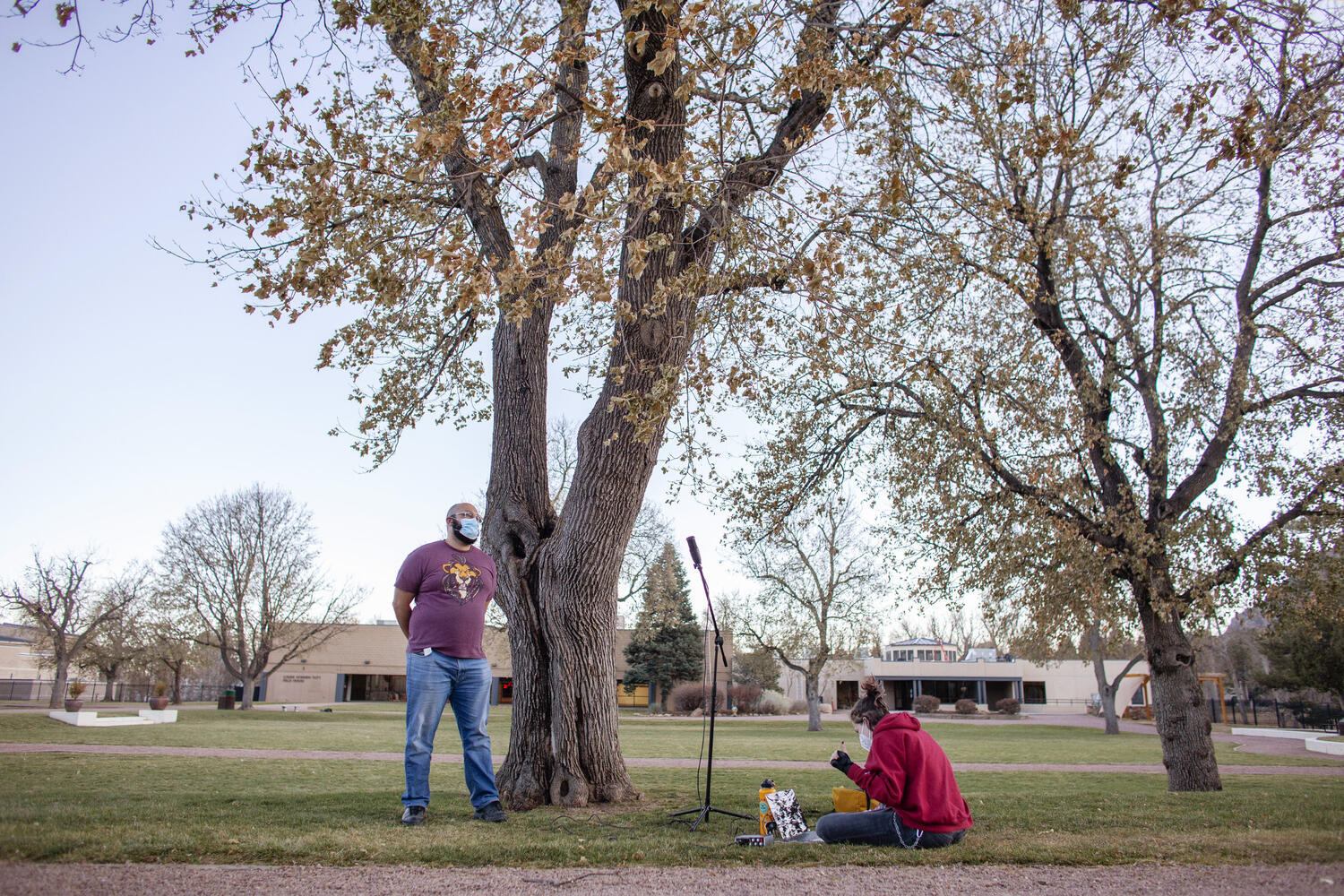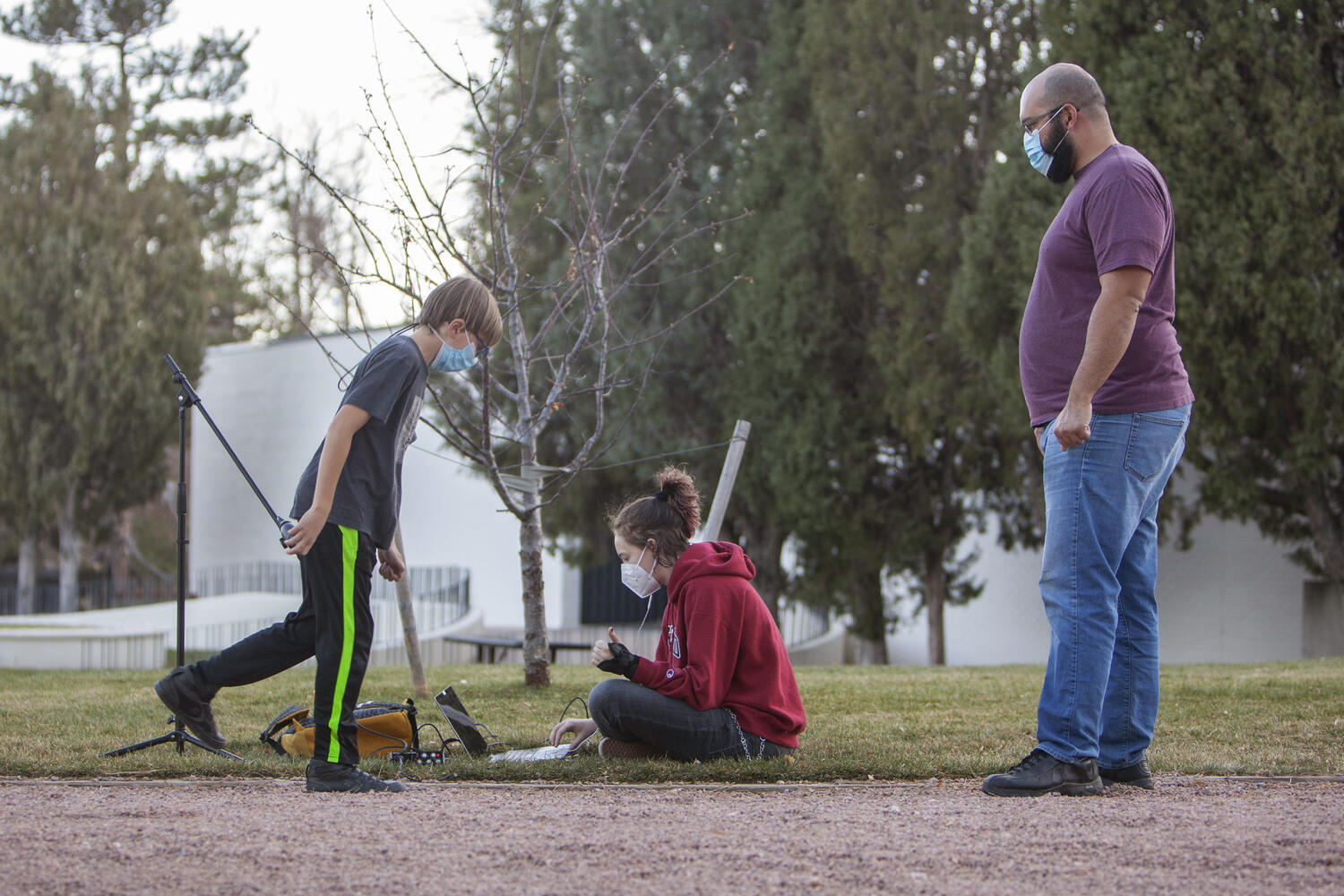Upper School students at The Colorado Springs School are learning new ways to stretch their voices for their upcoming production, Trap, a mystery-thriller radio play that focuses on sound.
“It’s different from anything I’ve ever done,” senior Whitney R. ‘21 said. “It’s different because so much of what I’ve learned is how we can use our body to fill up space. I like being able to learn how to change every single word to make it sound how I want it to sound. Is it supposed to be funny or serious or sad? You really have to focus. I’ve never worked this much with my voice.”
Trap by Stephen Gregg is an incomprehensible plotline: every person in the audience of a high school play falls unconscious — every person but one. Using interviews with witnesses, loved ones, first responders, and the investigators pursuing the case, a theatre ensemble brings the story of the strange event to life, documentary-style. But as the strands weave together into an increasingly dangerous web, it becomes clear that this phenomenon might not be entirely in the past. Unnerving, exhilarating, and wildly inventive, you’ve never walked into anything quite like Trap. The play is suitable for Middle School students and older audiences.
“All of the characters are just trying to figure out what happened. It’s creepy until you put the pieces together,” said Jonathan Andujar, theatre teacher and play director. “The seniors are really stepping up and putting in high-quality performances, and I’m trying to foster the talents of some of the younger students as leaders who are up-and-coming in theatre.”
Mr. Andujar chose the radio play format as a way to adapt to COVID-19, allowing students to explore a creative outlet that they haven’t experienced before. Practice sessions were virtual. Students are individually recording their parts, and sound engineer junior Finnegan T. ‘22 will combine them for the final audio file. Audiences can enjoy the recorded play from the comfort of their homes because it will be released digitally, likely in the coming weeks.
Radio plays, which are similar to podcasts, were popular before movies became prominent.
“Many theatres are turning to radio plays, including the Fine Arts Center and many other major theatres,” Mr. Andujar said. “It’s going back to some theatre roots. It goes back to that storytelling, gathering around the fire, and in this instance, your mobile device.”
Each student plays different characters in Trap, requiring them to disguise their voices significantly so listeners believe it’s someone  else. Fifteen students — including voice actors, stage managers, and sound engineers — are working on the production.
else. Fifteen students — including voice actors, stage managers, and sound engineers — are working on the production.
“We really have to focus on the way our voices demonstrate who we’re playing rather than using our faces and bodies to tell the story,” said junior Sasha M. ’22. “In this play, all of us are playing at least two parts — most are playing three to four — so it’s definitely different from the past when we could rely on costume changes to differentiate our parts.”
Because the visual cues are taken away, Mr. Andujar said radio plays to a degree take a little more finesse and a little more vocal talent. A bonus is students read from the scripts.
“Voice acting is really fun. It’s been very different because all of it has been voice inflection instead of memorizing lines and stage blocking,” said senior Orlando M. ’21. “One of my characters is an architect. He’s kind of nerdy about architecture, so I get to change my voice to a nerdy scientist architect guy who is super excited about buildings, so that’s fun.”
Sophomore Nathan G. ’23, who plays five characters, has been learning the limits of his vocal range.
“In order to voice multiple characters in a purely auditory medium, one has to differentiate their voice pretty dramatically in order to make the distinction clear,” Nathan said. “I’ve had to try and experiment with pitches and accents so that my characters don’t sound the same.”
A radio play requires sound effects to indicate scenes such as walking down stairs, opening a door, an alarm going off, or a character falling to the floor. Senior Madeline K. ’21 and sophomore Haegan M. ’23 took on the roles of developing the sound effects and music for Trap. Both also play several characters.
“I’ve always wanted to work with radio and microphones and all that jazz,” said Haegan, who used to tremble from stagefright but has grown to adore theatre and expressing himself creatively.
Haegan is composing music for the play by creating tunes on the piano, then switching to a mini keyboard to record.
“I like to do it as a hobby. It’s applying something I love to something else I love,” he said. “The theme is scary, so it’s either a piece to make you jump out of your seat or something more suspenseful.”
Audiences that are used to watching stage productions will have to engage other senses for the radio play.
“It’s something you can play multiple times,” Mr. Andujar said. “You can rewind to listen to some clues. And there are some clues about what is happening very early on, but if you don’t know to listen for them, then it just goes right over your head. The audience can have a fun time pausing and rewinding. They’ll have to get familiar with a different medium.”
This is Mr. Andujar’s first production at CSS. Teaching Middle and Upper School theatre arts and Middle School Spanish, he joined the faculty this year when Ms. Sandy Bray retired after 25 years of dedicated service.
“He’s amazing,” said Whitney, who had worked with Ms. Bray since kindergarten. “He really knows how to talk to us, to drive home the point that you can do so many things with acting here. He’s not afraid to give feedback, and I love that,” she said. “I think if I had to choose anyone to follow Ms. Bray, it’d be him.”
Stay tuned: The final arrangements of the radio play audio files are being mixed and will be released in the weeks to come. Trap is suitable for Middle School students and older audiences.











